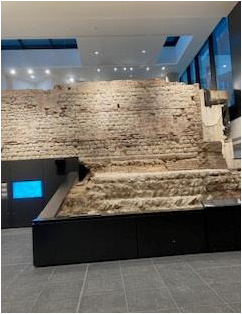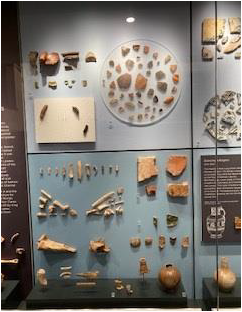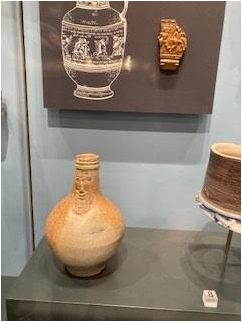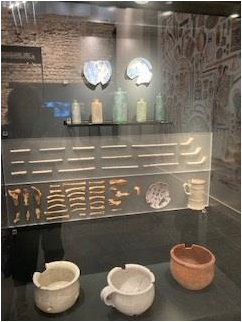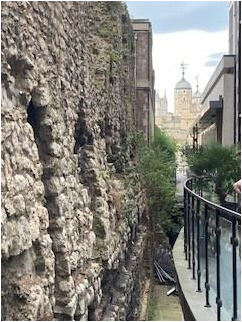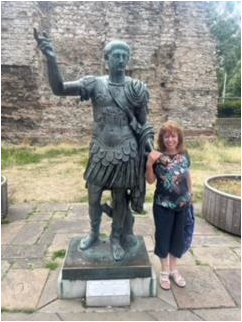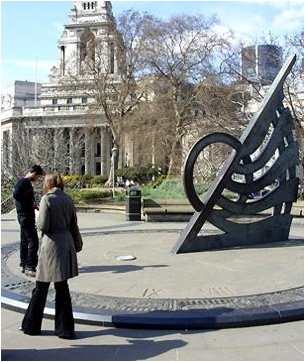
No. 629 August 2023 Edited by Jim Nelhams
HADAS DIARY – Forthcoming Lectures and Events
Lectures, which are currently not on Zoom, are held in the Drawing Room, Avenue House, 17 East End Road, Finchley N3 3QE. 7.45 for 8pm. Tea/Coffee/biscuits available for purchase after each talk. (Cash please.)
Buses 13, 143, 125, 326 and 460 pass close by Avenue House, and it is a five to ten-minute walk from Finchley Central Station on the Barnet Branch of the Northern Line. Bus 382 passes close to Finchley Central Station.
Tuesday 12th September 2023 Mike Noronha, Barnet Museum
The Battle of Barnet Survey and Project
Tuesday 10th October 2023 Lecture to be arranged
Tuesday 14th November 2023 Kris Lockyear
Mapping Verulamium
Saturday 16th September, 10am – 4pm
HADAS “Open Day” at Avenue House
See poster below
Subscriptions by Cheque
The annual subscription was due on the 1/4/2023. Members who pay by cheque and have not yet sent their cheque, please address it to:
HADAS
C/o Avenue House, 17 East End Road, Finchley. London N3 3QE
If you have sent your cheque to Steve Brunning’s old address, please let us know.
Future Newsletters
HADAS nearly did not have a newsletter this month. At the deadline given in last month’s newsletter, only one article had been received which would have given us 4 pages after including the list of Other Societies’ Events. Postage and printing would still have cost the same amounts if we used four pages.
This is your newsletter and you can help to keep it going by submitting items of interest. Even half a page helps. We could also do with another couple of editors – which involves assembling submitted items – not writing them – unless you want to. Contact jim_nelhams@hotmail.com if you can help in any way, or for more information.
Thank you.
1
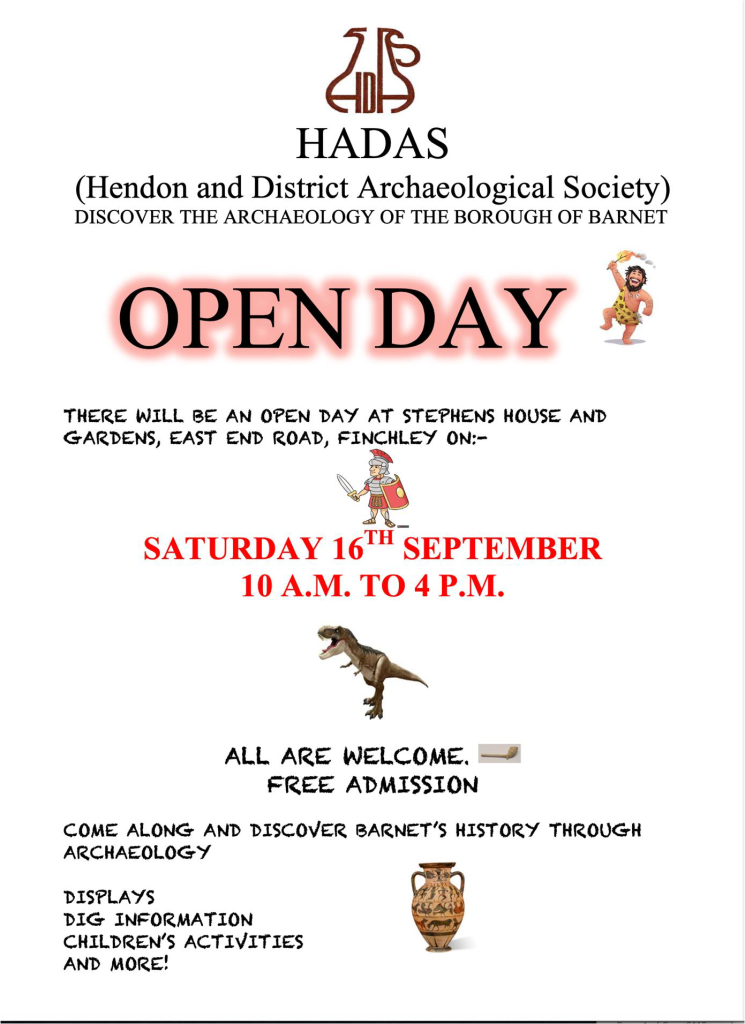
No Dinosaurs were hurt in the making of this poster, if you want to help let us know. Its archaeology not paleontology. We know you know. ****************************************************************
2
The City Wall at Vine Street Janet Mortimer
Underneath a coffee shop a short walk from Tower Hill Station is one of the newest chances to see more of the London Roman City Wall. This little publicised and hard to find site opened in May of this year and is a fascinating glimpse of the wall built 2,000 years ago. The large section of wall, complete with bastion reminds us how durable the structures built by the Romans were, especially contrasted with the nearby very modern “Shard” and “Cheesegrater” buildings.
Items that were found during the excavations are displayed in a very pleasing manner in cabinets ranging from the oldest finds to the newest. The captions are interesting and informative, with comments such as wondering what the Romans would say if they could see us getting excited over their rubbish – and wondering what archaeologists of the future will make of our own rubbish!
3
Although not large, a visit to this attraction is well worth it, especially as it is free (although you need to pre-book). There are other outside sections of the Roman Wall that you can visit whilst you are in the area, and you can even hold hands with Trajan!
The Tower Hill Sundial Jim Nelhams
Just up the stairs from the statue of Trajan to the south of Tower Hill Station is a large sundial. Around its edge are pictures reflecting the history of London from AD43. Look especially at “The Peasants’ Revolt”. In one corner in the cload, there is a familiar lady waving her handbag!!!
4
HADAS Excavation at ‘Hopscotch’ 88 High St, Barnet EN5 5SN
(Part 6 the finds – Animal Bones, by Geraldine Missig.)
Site code OPS22
‘Hopscotch’, a shop located at 88 High Street, Barnet, hosted in its backyard an exploratory trench which produced 88 animal bone fragments of which 67 weighing 1394g were identified to species and anatomical part. Unfortunately, 20 fragments weighing 107g lacked the sufficient distinguishing features for identification. Of the 20 fragments, ten were sheep size, eight were cattle size and two were unidentified bird. In addition to the bone group, 18 oyster shell fragments, weighing 94g were retrieved.
Method
The bone fragments were identified by reference to the bone collection at Birkbeck, University of London and recorded for HADAS on an Excel spreadsheet noting species, anatomical part, side, state of fusion (following Schmid 1972), proportion of bone present, weight, and any modification such as dog or rodent gnawing, charring or butchery.
Cohen & Sarjeantson’s manual for the identification of birds (1996), was used to verify the identity of the bones of domestic fowl and woodpigeon from (001).
Apart from a deciduous fourth premolar and distal metatarsal, both of which were identified as sheep, there were no other diagnostic fragments among the caprine elements to distinguish between sheep and goat, which below will be referred to as sheep. (Boessneck 1969).
Mandible wear stages followed Grant’s illustrations of tooth wear stages (1982) with Payne’s suggested age attribution for eruption/wear state (1973) for sheep/goat.
All measurements were made by vernier callipers according to the von den Driesch guidelines.
Each identified specimen was counted (NISP) and where two fragments joined, they were counted as one. All oyster fragments were counted NISP but their minimum number (MNI) was established by the presence of more than 50% of its hinge on the left valve, the more numerous side present.
Assemblage
This small bone group was assembled from three presently undated contexts to which the bone contents of the trench had been allocated. (001) comprised 31 bone fragments, (002) only had 16 and (003) slightly more at 20. Together they contained an assortment of species.
Sheep were the most numerous having 27 fragments, cattle next with 18 fragments, pig followed with nine, bird with eight, rabbit with three and horse and dog each with one. Oyster fragments numbered 18.
Apart from (002) where sheep and cattle were equally frequent, sheep was the more numerous group in the other two contexts. The cattle fragments slightly increased in number through the contexts from (001) to (003) while the pig fragments moved the other way, fragment numbers decreasing from (001) to (003).
Although the three most numerous species contained some domestic refuse; cattle with its meatier sections of rib (in all contexts but much more frequently in (003)), pig with a solitary limb shaft (003), and sheep with the largest number of meaty shafts (001) (003), a few of the meatier rib sections (001) (003), and a lumbar vertebrae (001) (commonly recognised as a loin lamb chop bone), it was butchery waste which was more dominant.
5
Cattle contained large roughly chopped fragments of lumbar and thoracic vertebral fragments (002) while there was one of the latter from sheep in (003). All three species were represented by butchered fragments of the less meaty chopped ribs (all three contexts) as well as the awkward articular ends of shafts or blades (all three contexts), the latter inadvertently suggesting in their absence what people were actually eating.
The presence of the cranial elements, maxillary and mandibular parts of sheep (all three contexts) and cattle (001), as well as the skull fragments of pig (002) and sheep (003), and cattle extremities (002) (003), all normally slaughter waste, raise the possibility that the local butchers of that period undertook more intensive duties towards the preparation of an animal carcass for consumption.
OPS22 also contains an entire cattle metacarpal (003) and similarly that of a horse (002). The metacarpal is a lower leg bone covered in little meat but in a large animal its length, smooth line and strength made it a useful resource in bone working. However, both metacarpals display several small knife nicks normally associated with the skinning of an animal. The length of a complete fused metacarpal can be used in established equations to calculate an estimate of the withers heights of a bone’s owner.
The greater length of the (003) cattle metacarpal (von den Driesch) is 19.04cm which if multiplied by 6.03, a multiplier introduced by Matolcsi (1970), which is not reliant on gender distinction, produced an estimated withers height for the animal of 1.15m. Comparing this figure, as (003) is presently undated, with today’s average withers height of between 1.37-1.5 for Angus or Holstein Friesian cattle, suggests that the (003) animal was quite small.
The maximum lateral length, 22.14cm, of the horse metacarpal (von den Driesch) multiplied by 6.41 (the factor following Kiesewalter (1888) and described by Chroszcz et al. (2014)) gives an estimate of withers height as 142cm or 14hands. This short estimated withers height places the animal near the borderline territory between a large pony and a small horse, but just misses the 14.3 hands high needed to be classified as a small horse.
The eight bird bones recovered came only from (001). Apart from any of the myriad reasons why bird bones did not land up in the earth of a particular back yard, a bird needs to have light bones to be able to fly. They are thus more fragile and vulnerable to destruction than the bones of other animals. Following the butchery evidence below, (001) may be the latest in time of the three contexts, another possible reason why bird was not found in the other contexts.
The bird fragments consisted of the bones of seven domestic fowl and one wood pigeon. Domestic fowl is represented by the classic food bones, the upper thigh bone and the bones of the meatier part of the wing, suggesting domestic refuse. Judging from the numbers of the same bones of the same side they would represent two birds.
The wood pigeon’s ulna, one of the bones from the meatier part of the wing, could have been in the yard as a consequence of a natural event. However, as it occurs in association with the group of domestic fowl bones and a chopped rabbit bone, mentioned below, it may suggest the exploitation at that time of local fauna in the sourcing of food.
A few rabbit bones, two pelves and a chopped thigh bone, were present in (001) and (002). The thigh bone also displays a small knife nick at the distal end, often the result of skinning. The bones’ presence supports the suggestion that local animals were used for food and, depending on the dates to be established for these contexts, practices continuing over some time.
Oyster shells appear in (001) and (002), predominantly in (002). Although breakage has occurred in (002) there were six left hand, the rounder side, remnants with more than 50% of their hinges present in the group which indicate that there were at least 6 oysters in the group.
6
Several of the valves exhibited marks suggestive of interference at the side or near the hinge area but the fragmentation is too extensive to be certain.
The hinge of the oyster shell in (001) appears to be that of a right valve, the shallower side. Interference near the hinge and a few knife marks visible on the interior surface of the shell suggest that it had been used for food.
Condition
Eighty five percent of the bone group was in average condition displaying only moderate erosion after their spell in the ground. Damage to the bone by the gnawing of rats or dogs, surface splitting, flaking or thinning contributed in varying degrees to a poor or severe state in the condition of the remaining 15%.
Rat or dog gnawing was observed in 21% of the bone assemblage but rat gnawing unusually only occurred in (001) while dog gnawing appeared equally only in (002) and (003). It may be that (002) and (003) came from a different time and source and had been buried more quickly than (001).
The surface of the majority of the oysters, largely found in (002), was extremely friable. The right valve of the more robust less fragmented but only oyster fragment in (001) displayed a single hole on the exterior of its valve made by a sponge or predatory marine gastropod trying to attach to its shell.
Charring
There was no evidence of charring on any of the fragments.
Butchery
Fifty four percent of the bone fragments showed signs of butchery. This amount rises to 69% if the horse, dog and bird bones were removed from the equation as customarily they are not butchered, as they are not in this assemblage.
The rates of butchery increase in OPS22 as the contexts numbers move from (001) to (003) but the greatest difference between the contexts is that it is only in (001) that saw marks appear. Sawing as a method of butchery only became a common practice in the 19th century suggesting a possible more recent date for (001) than the other two contexts.
The crumbly and fragmented condition of the oyster fragments in (002) obscured any marks though there may have been some possible interference at the sides or near the hinges. Interference near the hinge area of the sturdier oyster fragment in (001) was more visible, as were the few knife marks on its interior.
Age Evidence
There is some evidence of a number of young animals in this assemblage.
Birds will display their youth by having long bones with soft ends which have not yet hardened. In OPS22, many of the bones of domestic fowl which have complete endings are soft, indicating immature birds.
There are a group of young animals in OPS22, mainly sheep and pigs, whose full growth had not been completed before death so the ends of their limb bones had not yet attached to their shafts and hardened. The general age of an animal at which this fusion for each bone occurs is known, which helps to furnish an approximate age at death should the animal die before a bone’s fusion is achieved.
7
In (001) there are four, two pigs and two sheep, whose unfused shaft ends of bones indicate that all these animals were less than 3.5 years old when they had been butchered. Additionally the unfused end of another young pig bone showed it was slaughtered at less than one year, while in (003) a young pig’s unfused shaft end marked its death at around two years old.
In (002) there is a mandible of a young sheep whose tooth eruption and wear point to its slaughter at around six months old.
There are no cattle teeth in OPS22 to assess age by means of the stage of tooth eruption or patterns of tooth wear. Additionally the cattle bones in the group which are fused are those which complete the fusion process early in life, around one or two years, leaving too great an age range to be useful. At the other end of the spectrum there is a chopped unfused thoracic vertebra which fuses between 7 and 9 years.
However, there is one cattle bone fragment from (002), in two pieces, whose proximal articular end is in the process of firmly attaching to its shaft but hasn’t fully completed it as the line between the shaft and the attaching epiphysis is still visible. The age for the fusion of the proximal end of this bone, the humerus, is thought to be around 3.5 to 4 years old, placing the age of this animal at death at around the 4 year mark, an age at which the animal would have achieved its full growth.
Barring illness or accident, dairy or draught cattle have a longer lifespan than 4 years, which points to this animal in (002) having been raised for meat production as were the above other young sheep and pigs from (001), (002) and (003).
There are also a few cases of disposal, for no apparent reason, of the very young who had not been involved in the preparation and supply of meat. Single limb bones of a neonatal dog and pig, and that of a slightly older sheep appeared in (001) and (002).
Conclusion
The anatomical parts recovered suggest that the assemblage has been derived from a variety of activities. That the fragments have been disposed of in the same area suggests the proximal nature of these different sources.
(001) is notable as it is more numerous than the other contexts, containing not only the largest amount of pig fragments in the group but also the largest presence of young animals and birds in the assemblage. It is also the only context which displays sawn bone and rat gnawing.
Domestic refuse appears to be represented by the partial remains of at least six oysters, the meatier parts of the rabbit, domestic fowl and cattle ribs, and the occasional limb bone of sheep and pig.
Butchery waste is more common, consisting of sheep, cattle and pig’s unwanted awkward articular ends of long bones, pelves, less meaty parts of ribs and the vertebral fragments of the two most numerous species. The youth of the animals slaughtered enhances the quality of the meat supplied which in turn suggests the prosperity of the nearby community or part thereof.
Cranial elements from cattle, sheep and pig, including mandibular, maxillary and occipital skull fragments and extremities suggest slaughter waste or possibly the earlier involvement of the butcher at that time in the processing of animal carcasses for consumption.
A semi circular cut on a cattle humerus from (002) implies nearby casual bone working activity. Knife nicks on a rabbit’s femur (001) and on cattle (003) and horse (002) metacarpals suggest the local skinning of animals.
8
An intact horse lower leg bone from (002) and one from cattle in (003), as well as unfused limb bones of a neonatal puppy (001) and piglet and a slightly older sheep (002) possibly reflect the yard’s proximity to a well used road and might suggest it was a recognised place for the disposal of unwanted animal bone.
When dating is available and assigned to contexts (001) to (003), the information uncovered by the animal bone assemblage will contribute to a greater understanding of High Barnet’s local patterns of meat supply and consumption in their time frame. As OPS22’s bone group is not large, its value will be amplified with the excavation of further nearby sites.
Bibliography
‘Aberdeen Angus Cattle’, https://attwellfarmpark.co.uk/explore/animals/aberdeen-angus-cattle.. Accessed 28/07/22.
Boessneck. 1969, ‘Osteological differences between sheep (Ovis aries Linne) and goat
(Capra hircusLinne)’, in Brothwell, D. and Higgs, E.S. (eds.), Science in Archaeology, 2nd edn, London: Thames & Hudson.
Chroszcz, A. & Janeczek, M. & Pasicka, E. & Kleckowska-Nawrot, J. 2014, ‘Height at the withers estimation in horses based on the internal dimension of cranial cavity’, Folia morphologica, 73, 143-148. 10.5603/FM.2014.0021.
Cohen, A. & Serjeantson, D. 1996, A Manual for the Identification of Bird Bones from Archaeological Sites, London: Archetype.
Driesch, A. von den 1976, A Guide to the Measurement of Animal Bones from Archaeological Sites, Massachusetts: Peabody Museum of Archaeology and Ethnology Bull. 1.
Grant, A. 1982, ‘The use of tooth as a guide to the age of domestic animals’, in Wilson,
B., Greigson, C. & Payne, S. (eds) 1982, Aging and Sexing Animal Bones from Archaeological Sites, Oxford: BAR Brit. Ser. 109.
‘Holstein Friesian Cattle Dimensions & Drawings’, Accessed 28/07/22. https://www.dimensions.com/element/holstein-friesian-cattle.
Matolcsi, J. 1970, ‘Historische Erforschung der Kopergrosse des Rindes augrund von
ungarischem Knochenmaterial; Zeitschrift fur Tierzuchtung und
Zuchtungsbiologie, 87, 89-137
‘Measuring the Height & Weight of Horses’, https://allpony.com/learn/measure-horses/. Accessed 09/08/22.
Payne, S. 1973, ‘Kill-off patterns in sheep and goats: the mandibles from Asvan Kale’, Anatolian Stud. 23, 281-303.
Schmid, E. 1972, An Atlas of Animal Bones for the Prehistorians, Archaeologists and Quaternary Geologists, Amsterdam: Elsevier.
Winder, J.M., 2011, Oyster Shells from Archaeological Sites: a brief illustrated guide to basic processing, 23-24, 28.
natureinfocus.files.wordpress.com/2019/10/oystershellmethodsmanualversion1.pdf 23rdJuly2022.
9
Other Societies’ Events Eric Morgan
Not all societies and other organisations have returned to pre-Covid conditions. Please check with them before attending events.
Sunday 6th August. Eclectic Tours. NW London Series. – Colindale and its role in early Aviation. Colindale or Hendon as it was known back then, was synonymous with flying. Learn about early aviation and other factories and important institutions of the area. For tour info. and to book please go to Eclectic Tours – Walking Tours – London, England (eclectic-tours.com).
Saturday 19th August. Barnet Physic Well. Cnr. Well Approach/Pepy’s Cres.,Barnet, EN5 3DY. Open Day.
Also Sunday 27th August. Exploring Kingsbury and Places we call Home. In the 1930’s Kingsbury developed as part of Metroland , while typical of many suburbs with mock-Tudor houses, Kingsbury holds some surprises. For tour info. and to book please go to Eclectic Tours – Walking Tours – London, England (eclectic-tours.com).
Sunday 3rd September, 11am-5pm. Angel Canal Festival. Regent’s Canal, City Road Basin ,Islington,N1 8GJ. Lots of stalls including London Canal Museum. Also boat trips, craft stalls, food and live music. For more info, please visit www.canalrivertrust/events.
Wednesday 6th-Sunday to 17th September. Open House London. Free entry to London’s best buildings not normally always open to the public. For full detail. please visit https://open-city.org.uk
.
Sunday 10th September. Avenue House. The Private World of Spike Milligan. An opportunity to take a look at Spike’s unseen archive guided by his daughter Jane Miliigan. Small groups. Multiple slots. Booking essential. Tickets £10. Please visit www.stephenshouseandgardens.com.
Monday 11th September, 3pm.Barnet Museum and Local History Society.St. John the Baptist Church, Chipping Barnet, corner of High St./Wood St., Barnet, EN5 4BW. A Walk in the Park-London’s Green Treasures. Talk by John Lynch. Please visit www.barnetmuseum.co.uk.
Friday 15th September, 7.30pm. Enfield Archaeological Society, Jubilee Hall, 2, Parsonage Lane, Enfield, EN2 0AJ. London’s Waterfront, 1666-1800 and London’s Involvement with Slavery. Talk by John Scofield .Please visit www.enfarchsoc.org for further details.
Saturday 16th September 10am – 4pm. HADAS OPEN DAY at Avenue House. See Page 2 of this newsletter.
Sunday 17th September, 12-5pm . Queens Park Festival. Off Chevening Road or Harvist Road.,NW6. Lots of stalls incl.Willesden Local History.
Wednesday 20th September, 7.30pm. Willesden Local History Society. St.Mary’s Church Hall, bottom of Neasden Lane, NW10 2TS (round corner from Magistrates’ Court). Shopping in Kilburn High Road. Talk. May also be on zoom. If not a member, buy a ticket (£3). For details .please visit www.willesden-local-history.co.uk.
10
Friday 22nd September,7pm. COLAS. St.Olave’s Church, Hart Street , EC3R 7NB. Lord Elgin and the Parthenon sculptures at the British Museum. Speaker TBA. Hopefully also on zoom.Please book via Eventbrite. Visit www.colas.org.uk. HADAS may send out the link details to its members to book.
Saturday 23rd and Sunday 24th September. Clitterhouse Farm Project. 10th Anniversary Weekend. 102,Clitterhouse Crescent,NW2 1DN. For details, please e-mail paulette@clitterhouse.com or visit www.ouryard.org.
Wednesday 27ih September, 7.45pm. Friern Barnet and District Local History Society. North Middx. Golf Club, The Manor House, Friern Barnet Lane, N20 ONL. Alexandra Palace Theatre. Talk by Nigel Wilmott. Please visit www.friernbarnethistory.org.uk and click on programme,or phone 020 8368 8314 for up-to-date details. (David Berguer, Chair). Non-members £2. Bar available.
Thursday 28th September, 7.30pm. Finchley Society. Drawing Room, Avenue, House, 17,East End Rd.,N3 3QE. Amy,wonderful Amy. Talk by David Keen (RAF Mus.) Will tell the life story of Amy Johnson and make use of the magic lantern slides and script which she used during fund-raising tours following her pioneering solo Australia flight. For further details, please visit www.finchleysociety.org.uk. Non-members £2 at the door. Refreshments in interval.
++++++++++++++++++++++++++++++++++++++++++++++++++++++++++++++
With many thanks to this month’s contributors: Geraldine Missig. Eric Morgan, Janet Mortimer, Jim Nelhams
++++++++++++++++++++++++++++++++++++++++++++++++++++++++++++++
11
Hendon and District Archaeological Society
Chairman Don Cooper, 59, Potters Road, Barnet EN5 5HS (020 8440 4350)
e-mail: chairman@hadas.org.uk
Hon. Secretary Janet Mortimer, 34, Cloister Road, Childs Hill, London NW2 2NP
(07449 978121) e-mail: secretary@hadas.org.uk
Hon. Treasurer Roger Chapman, 50, Summerlee Avenue, London N2 9QP
(07855 304488) e-mail: treasurer@hadas.org.uk
Membership Secretary Vacancy
While we have no Membership Secretary
for the present, please address any change of member addresses or other miscellaneous correspondence to:
HADAS, c/o Avenue House, 17 East End Road, Finchley, London N3 3QE
Website at: www.hadas.org.uk – join the HADAS email discussion group via the website.
12

